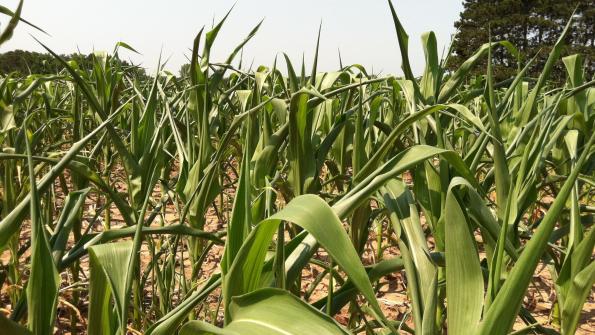July 27, 2012

The severe drought in the Midwest has caused complete crop failure in some areas; in others, yields are reduced to the point that it is not economical to harvest the grain. Producers who are considering baling or chopping for silage have asked University of Illinois Assistant Professor Fabián Fernández how much nutrient would be removed if the stunted corn crop is taken out of the field.
“The condition of the drought-affected corn crop is so varied that it would be difficult to establish a removal rate that represents every condition,” he says.
To determine total nutrient removal, the amount of biomass and nutrient concentrations must first be determined. Fernández notes that doing so is difficult because some crops died while they were still at vegetative stages, others are dying with barren ears, and others are hanging on trying to fill the kernels.
“Normally, the first step in determining total nutrient removal in stover is to use a harvest index, also known as residue-to-corn grain ratio, to estimate how much stover has been produced,” he explains.
The most widely used dry weight ratio is one-to-one residue to grain. Using this ratio to calculate the pounds of dry residue, the grain yield in bushels per acre is multiplied by 47.3 (a 56-lb. bu. of corn at 15.5% moisture contains 8.7 lbs. of water). The value is divided by 2,000 to obtain the number of dry tons produced.
This approach will not work well this year.
“One could expect to remove up to about 1 ton of dry biomass/foot of corn height/acre if the stalk diameters are small,” Fernández explains. “If the stalks have a more typical diameter, I would estimate as much as 1.2-1.3 tons of dry biomass/acre/foot of corn height.”
The amount of biomass removed also depends on the cutting height: the higher the cutting height, the less stover is removed. Thus, the best way to determine total amount produced would be by weight of bales or silage loads adjusted for moisture content.
Nutrient concentration
Nutrient concentration is the other piece of information needed to determine nutrient removal amounts. In a normal growing season, phosphorus (P) and potassium (K) levels in biomass can vary considerably. Typical values for stover after grain harvest range from 5 to 8 lbs. of P2O5/ton and from 5 to 40 lbs. of K2O/ton, with 20-30 pounds K2O/ton being the normal range. Low K levels are usually due to rain leaching it out of the plant after the crop starts dying – obviously not a problem this season.
Removal values vary under normal circumstances. The droughty conditions make it even more difficult to estimate a value that applies to all locations. “Severe drought conditions reduce the crop’s capacity to take up nutrients; thus, we expect to find lower-than-normal amounts in the vegetative tissues of the corn crop this year,” Fernández says.
By the R1-R2 development stage in a normal growing season, plants have taken up nearly all of the K (around 170 lbs. K2O/acre) and approximately half of the P (around 40 lbs. of P2O5/acre). All of the nutrients are present in the vegetative tissues at these stages. As seeds start to form, some of the P and K in the tissues translocates into the seeds. By physiological maturity (R6), approximately 20 lbs. of P2O5/acre and 120 lbs. K2O/acre remain in vegetative tissues and cobs.
“The best way to determine nutrient content is to collect a representative sample of the harvested material and send to a commercial lab for nutrient analysis,” Fernández advises. “It is important to perform nutrient analysis on drought-stressed corn to determine nitrate concentrations if it is going to be used for livestock feeding. Asking for P and K analysis at the same time does not add much to the cost.”
P & K decisions this fall
Fernández offers some general guidelines and indicated some important points to consider when making phosphorus and potassium fertilizer decisions for this fall.
The amount of P removed by harvesting biomass will probably be lower than what is removed when only grain is harvested. If a low yield of 4 tons of dry biomass/acre is harvested at 5 lbs. P2O5/ton, the removal would be 20 lbs. P2O5/acre. Even with 40 lbs. P2O5/acre (the amount accumulated in vegetative tissues by R1 under normal growing-season conditions), the removal values are lower than the 77 lbs. P2O5/acre removed when harvesting 180 bu. of grain/acre.
For K, however, removal rates can be much higher than normal removals with grain harvest. Using the same low yield of 4 tons of dry biomass/acre, if the material contains 20 lbs. K2O/ton, the crop would remove 80 lbs. K2O/acre; if the material contains 30 lbs. K2O/ton, then 120 lbs. K2O/acre would be removed. The estimated amounts are higher if 170 lbs. K2O/acre, which is the accumulation in vegetative tissues at R1-R2 under normal growing-season conditions, is used for the calculation.
Whichever estimate is used, they are all much higher than the normal removal rate of 50 lbs. K2O/acre for a grain yield of 180 bu./acre. However, if grain yields are low and the biomass is not harvested, the removal rates will be lower than normal.
“Whatever your particular situation is, it is very important to account correctly for removal rates to manage fertilizer applications this fall,” Fernández advises.
(For more information on how to feed drought-stressed corn with high nitrate concentrations to livestock, see: http://web.extension.illinois.edu/drought.)
You May Also Like




